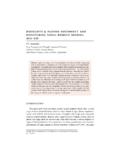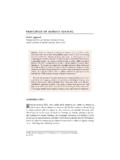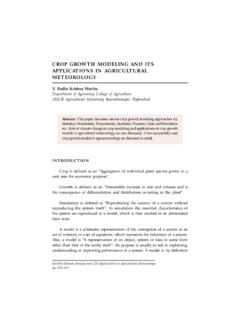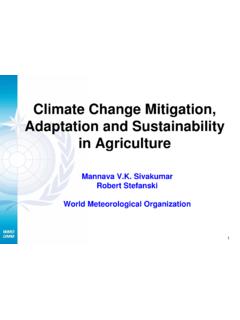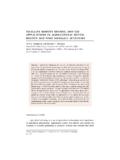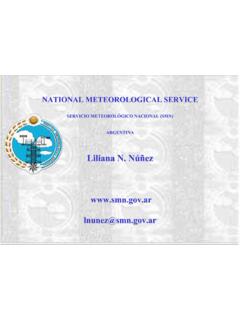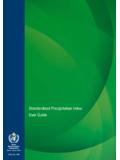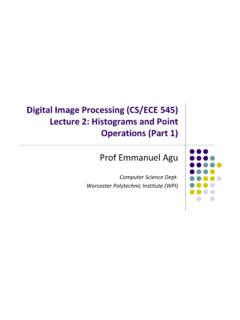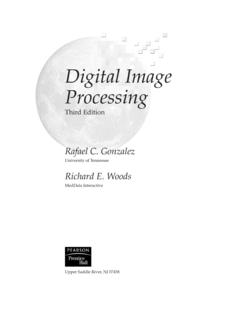Transcription of DIGITAL IMAGE PROCESSING - wamis.org
1 DIGITAL IMAGE PROCESSINGM inakshi KumarPhotogrammetry and Remote Sensing DivisionIndian Institute of Remote Sensing, Dehra DunAbstract : This paper describes the basic technological aspects of DIGITAL ImageProcessing with special reference to satellite IMAGE PROCESSING . Basically, all satelliteimage- PROCESSING operations can be grouped into three categories: ImageRectification and Restoration, Enhancement and Information Extraction. The formerdeals with initial PROCESSING of raw IMAGE data to correct for geometric distortion,to calibrate the data radiometrically and to eliminate noise present in the enhancement procedures are applied to IMAGE data in order to effectively displaythe data for subsequent visual interpretation.
2 It involves techniques for increasingthe visual distinction between features in a scene. The objective of the informationextraction operations is to replace visual analysis of the IMAGE data with quantitativetechniques for automating the identification of features in a scene. This involvesthe analysis of multispectral IMAGE data and the application of statistically baseddecision rules for determining the land cover identity of each pixel in an intent of classification process is to categorize all pixels in a DIGITAL IMAGE intoone of several land cover classes or themes.
3 This classified data may be used toproduce thematic maps of the land cover present in an are the most common and convenient means of conveying ortransmitting information. A picture is worth a thousand words. Picturesconcisely convey information about positions, sizes and inter-relationshipsbetween objects. They portray spatial information that we can recognize asobjects. Human beings are good at deriving information from such images,because of our innate visual and mental abilities. About 75% of theinformation received by human is in pictorial the present context, the analysis of pictures that employ an overheadperspective, including the radiation not visible to human eye are Remote Sensing and GIS Applications in Agricultural Meteorologypp.
4 81-10282 DIGITAL IMAGE ProcessingThus our discussion will be focussing on analysis of remotely sensed images are represented in DIGITAL form. When represented as numbers,brightness can be added, subtracted, multiplied, divided and, in general,subjected to statistical manipulations that are not possible if an IMAGE ispresented only as a photograph. Although DIGITAL analysis of remotely senseddata dates from the early days of remote sensing, the launch of the first Landsatearth observation satellite in 1972 began an era of increasing interest inmachine PROCESSING (Cambell, 1996 and Jensen, 1996).
5 Previously, digitalremote sensing data could be analyzed only at specialized remote sensinglaboratories. Specialized equipment and trained personnel necessary to conductroutine machine analysis of data were not widely available, in part because oflimited availability of DIGITAL remote sensing data and a lack of appreciationof their IMAGEA DIGITAL remotely sensed IMAGE is typically composed of picture elements(pixels) located at the intersection of each row i and column j in each K bandsof imagery. Associated with each pixel is a number known as DIGITAL Number(DN) or Brightness Value (BV), that depicts the average radiance of a relativelysmall area within a scene (Fig.)
6 1). A smaller number indicates low averageradiance from the area and the high number is an indicator of high radiantproperties of the size of this area effects the reproduction of details within the pixel size is reduced more scene detail is presented in DIGITAL 1 : Structure of a DIGITAL IMAGE and Multispectral IMAGE 1 2 3 4 Pixels Scan Lines BandsPixelsScan Lines10 15 17 20 2115161821 2317182022 2418202224 2618202225 25 Origin (0,0)Minakshi Kumar83 COLOR COMPOSITESW hile displaying the different bands of a multispectral data set, imagesobtained in different bands are displayed in IMAGE planes (other than theirown) the color composite is regarded as False Color Composite (FCC).
7 Highspectral resolution is important when producing color components. For a truecolor composite an IMAGE data used in red, green and blue spectral regionmust be assigned bits of red, green and blue IMAGE processor frame buffermemory. A color infrared composite standard false color composite isdisplayed by placing the infrared, red, green in the red, green and blue framebuffer memory (Fig. 2). In this healthy vegetation shows up in shades of redbecause vegetation absorbs most of green and red energy but reflectsapproximately half of incident Infrared energy.
8 Urban areas reflect equalportions of NIR, R & G, and therefore they appear as steel 2: False Color Composite (FCC) of IRS : LISS II Poanta areaIMAGE RECTIFICATION AND REGISTRATIONG eometric distortions manifest themselves as errors in the position of apixel relative to other pixels in the scene and with respect to their absoluteposition within some defined map projection. If left uncorrected, thesegeometric distortions render any data extracted from the IMAGE useless. Thisis particularly so if the information is to be compared to other data sets, be itfrom another IMAGE or a GIS data set.
9 Distortions occur for many Colour GunAssignmentBlue GunGreen GunRed GunGreenInfraredRed84 DIGITAL IMAGE ProcessingFor instance distortions occur due to changes in platform attitude (roll, pitchand yaw), altitude, earth rotation, earth curvature, panoramic distortion anddetector delay. Most of these distortions can be modelled mathematically andare removed before you buy an IMAGE . Changes in attitude however can bedifficult to account for mathematically and so a procedure called imagerectification is performed. Satellite systems are however geometrically quitestable and geometric rectification is a simple procedure based on a mappingtransformation relating real ground coordinates, say in easting and northing,to IMAGE line and pixel is a process of geometrically correcting an IMAGE so that it canbe represented on a planar surface , conform to other images or conform to amap (Fig.)
10 3). That is, it is the process by which geometry of an IMAGE is madeplanimetric. It is necessary when accurate area, distance and directionmeasurements are required to be made from the imagery. It is achieved bytransforming the data from one grid system into another grid system using ageometric is not necessary if there is no distortion in the IMAGE . Forexample, if an IMAGE file is produced by scanning or digitizing a paper mapthat is in the desired projection system, then that IMAGE is already planar anddoes not require rectification unless there is some skew or rotation of the and digitizing produce images that are planar, but do not containany map coordinate information.
